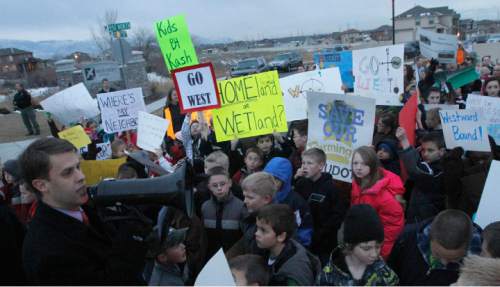This is an archived article that was published on sltrib.com in 2016, and information in the article may be outdated. It is provided only for personal research purposes and may not be reprinted.
After more than two years of study, the Utah Department of Transportation on Friday took a significant step toward eventual construction of a new West Davis Corridor freeway — a northern extension of Legacy Parkway — by rejecting the so-called "Shared Solution" alternative to improve local roads and transit.
However, UDOT is still working on a final recommendation for the route of the proposed $600 million, 20-mile freeway through Davis and Weber counties — and says that decision is expected in a year.
This freeway has been opposed by the U.S. Army Corps of Engineers and conservation groups that worry it would destroy too many Great Salt Lake wetlands, grass-roots groups that fear it would demolish their homes, and transportation groups that said other alternatives make more sense.
Modeling of the Shared Solution showed it "did not provide a substantial reduction in congestion and delay," although it would provide some, said UDOT Project Manager Randy Jefferies. He said it would not "meet all transportation needs through 2040."
Roger Borgenicht, co-chairman of Utahns for Better Transportation, a prime sponsor of the Shared Solution, said UDOT and federal rules essentially give too much weight to the wrong type of criteria.
He said they give highest priority to allowing automobile traffic to travel at the highest speed, "so a freeway becomes the solution for trying to reduce delay and congestion, rather than trying to reduce the growth in vehicle miles traveled. In fact, the freeway will produce more vehicle miles traveled."
Increasing that traffic amid urban sprawl will worsen "our air quality problem and our congestion problem," Borgenicht said.
Utah Audubon Council spokesman Steve Erickson said Davis County residents should now "take a hard look at how we want communities to grow and develop over time, and whether those decisions should be based on commuting time during rush hour — or if we ought to look at more sensible criteria on how to base our future."
The Shared Solution proposed such things as upgrading existing east-west streets into more efficient boulevards, adding connected bike ways, improving transit (including limiting some road lanes to buses-only during peak hours) and land use to create compact neighborhoods where residents would not need to commute for jobs or shopping.
UDOT originally planned to make a final decision on where to put the freeway by the end of 2013, but delayed amid heavy protests of its proposed route and pressure to study the new Shared Solution put forth by critics.
While UDOT is rejecting the Shared Solution, Jefferies said the agency is adopting "many great ideas" that it proposed.
They include "noise-reducing pavement to help minimize impacts to the environment and to nearby neighborhoods. We'll use dark-sky lighting … we're lowering the profile [or elevation] of the corridor." Also, "We'll be working on landscaping and other aesthetic enhancements."
The Shared Solution also offered ideas that UDOT will use elsewhere in Davis and Weber counties, Jefferies said, including adding some crossings of local roads over Interstate 15 (without interchanges) to speed east-west traffic, trail connections to a FrontRunner station and use of meter signals on I-15 entry ramps to smooth traffic flow.
"It was a good process," Borgenicht said about UDOT's years-long consideration of suggestions from the Shared Solution Coalition of conservation, traffic and grass-roots groups.
However, some citizens groups have questioned how serious UDOT was, noting that during the extended study period it continued to buy property in the proposed freeway corridor and this spring put stakes in the ground marked "Hwy RxW," for highway right of way, in some areas. UDOT said that was just to mark its property for fences to allow leasing of some land.
UDOT continued to buy land, Jefferies said, because "we had other options on the table we couldn't ignore," and sought to preserve the corridor and prevent construction there.
Jefferies said UDOT took the Shared Solution proposal seriously.
"We spent over two years developing and evaluating this alternative. We met over 50 times with the coalition and cities to figure out what this alternative is and try to help us to succeed."
Now that the Shared Solution has been discarded, Jefferies said UDOT will work to address opposition by the U.S. Army Corps of Engineers — which had said it would block permits needed for the project because of damage the freeway could do to wetlands.
The corps warned in 2013 that federal law allows it to permit only the least-damaging alternative route that is practical.
It said UDOT's initial preferred route — which would begin at Glovers Lane in Farmington — "has the most acres of direct and indirect" impact of all finalist alternatives studied.
An alternative beginning farther north at Shepard Lane would be less damaging, the corps said.
But UDOT has said that route would destroy more homes and businesses. Other federal agencies, environmental groups and neighbors of Glovers Lane also have opposed the Glovers Lane option.
Jefferies said UDOT hopes to issue a final environmental impact statement, including a final route for the freeway, next spring — which is then still subject to federal approval.
No schedule has been penciled in for construction of the freeway because funding for it has not yet been identified.



